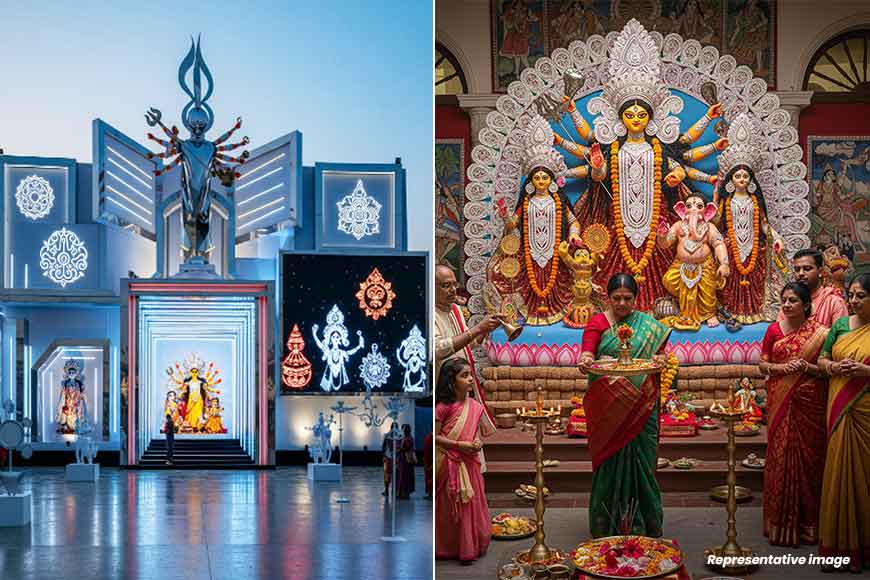Durga Puja—A Festival of Innovation, A Celebration of Roots - GetBengal Story

For Bengalis, Durga Puja is the greatest festival of all. We spend the entire year waiting eagerly for these five days. Boss’s scoldings, pending EMIs, even the upcoming board exams—everything feels tolerable only because of Puja.
In the nineteenth century, Hutom in his sketches wrote: “Gradually, the days of Durga Puja became shorter. The artisans of Krishnanagar spread across Kumartuli and Siddheswaritala. Shoe shops that were covered in dust swelled up like a bride during the Puja season. Shopfronts were pasted with coloured papers, chairs were set up inside over pieces of torn carpet. The closer the days came, the more crowded the markets became, the more Kolkata geared up.
Today Puja means theme. A large section of the younger generation equates joy with grand pandals, artistic decorations, fusion, art, and night-long hopping. Yet, even in this postmodern age, tradition holds its ground. The face of the Goddess, her raw golden complexion, the bamboo-leaf eyes overflowing with emotion still enchant us. We are nostalgic people. Happiness lies in remembrance. In Kaliprasanna’s words: “Durga Puja is a festival of Bengal; in the northern and western provinces, it is not even heard of.” The exact beginning of this Puja has been debated. According to legend, Raja Kangsanarayan of Tahirpur in present-day Rajshahi, during the time of Emperor Akbar, first organized Durga Puja in Bengal. That is where it began. A hundred years later, Krishnachandra sat on Nadia’s throne. It is said that through him Durga Puja entered the homes of Bengalis. Researcher Arun Nag’s observation is particularly important here. According to him, in the pre-colonial era local kings and landlords often avoided pomp in festivals for fear that if the Nawab heard of it, taxes might be raised. The English, however, had no such fear. Thus, under the Company, lavish expenditure became common.
In our childhood, theme pujas had not yet really started. We would go with our parents to see idols. Most were barowari pujas, organized by some club in a corner of the neighbourhood or in an open field. There wasn’t much extravagance. Small pandals, but the splendour was complete. A single-chambered goddess adorned in finery gazed at her devotees, with her children and Mahadeva beside her. The faint smell of incense spread across the courtyard. We children would look up at the chandelier in wonder, our eyes filled with delight. That grand glittering bunch of lights held such magic, such happiness! In the generation before us, this impression was even stronger. We have heard many stories from our fathers and uncles.
The root of tradition is ritual. And these customs, passed down through ages, were never confined to the city alone. Yet today, many accustomed to urban life overlook the suburbs. To them, villages don’t even count. “Is that even Puja?” they ask. This is where we have faltered. In our city-centric Bengali identity, we often blind ourselves. But the so-called marginalised continue in their own way. In a remote village of Purulia or an unknown hamlet of Bankura, there may be no banners, no media coverage, yet the divinity of the Goddess is no less. The autumn sky, the swaying fields of kaash, the simple mud houses—every pore breathes Bengal.
Theme pujas began only a few decades ago. At first, artists focused on pandal decoration, but gradually more layers were added with time. In the 1990s, a massive global change came with the fall of the Soviet Union and the rise of capitalism. Liberalisation reached India as well. During Puja, millions of people gathered, and in the eyes of the market, they were all consumers. As a result, brands—famous and unknown—jumped in to take control. Today whether in the city or in the suburbs, hoardings cover every corner. Bamboo frames are tied up a month before, and by Puja time, advertisements are everywhere. As Sankha Ghosh once said: “The face is hidden behind advertisements.”
For Puja committees, sponsorship holds immense importance. The money that flows in from banners is invested in decoration. The larger the crowd, the greater the gain. It becomes a loop. And so, to hold people’s attention, wonder is necessary. That wonder is supplied by themes. Through dazzling displays, spectators are drawn in. Alongside the divine form of Durga, we suddenly see undersea worlds with colourful fish, trains, airplanes, war-torn earth, the triumphs of science, or the raw wounds of violence against women. The contribution of themes to social awareness cannot be denied. Yet monotony creeps in. After all, this is the festival of the heart. And there, tradition still remains the guide and companion. Even in the age of Instagram algorithms and Facebook reels, Bengal’s traditional pujas remain equally popular—even among Gen Z. Media rushes from one city to another, from one village to the next, to cover them. Many watch from their homes, hands folded in prayer. And of course, Kumartuli photoshoots are always there.
From ancient tradition to today’s aesthetics, sabekiana has maintained both with equal grace, keeping intact the roots of the nation. So rather than unnecessary conflict, harmony should be the key. If theme is the structure, tradition is the foundation. If theme is the body, tradition is the heartbeat. And that is why Bengalis remain so emotional. “Krome dekhte dekhte dinmoni asto gelen, pujor amod pray sambatsorer moton phuralo! Bhorao okte bhayoron raginee te onek baarite bijoya gaona holo. Bhokter chokkhe bhogoboteer protima pordin praate molin molin bodh hote laaglo, seshe boshorjoner somaroho shuru holo - aaj Nironjon.”
Note:
Translated by Krishnendu Mitra
To read the original Bengali article, click here











